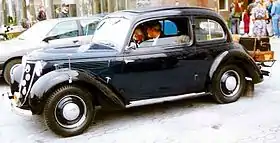Wanderer W24
The Wanderer W24 is a middle market car introduced by Auto Union under the Wanderer brand in 1937. The car was powered by a four-cylinder four-stroke engine of 1767 cc driving the rear wheels via a four-speed gear box. Claimed maximum power output of four cylinder Flathead engine[1] was 42 PS (31 kW; 41 hp) achieved at 3,400 rpm.
| Wanderer W24 | |
|---|---|
 | |
| Overview | |
| Manufacturer | Auto Union |
| Production | 1937 – 1940 |
| Assembly | Siegmar, Germany |
| Body and chassis | |
| Class | transmission = 4-speed manual with floor-mounted shift |
| Dimensions | |
| Wheelbase | 2,600–3,100 mm (100–120 in) |
| Length | 4,300 mm (170 in) |
| Width | 1,615 mm (63.6 in) |
| Height | 1,650 mm (65 in) |
The W24’s structural basis was a box frame chassis. At the back it employed a swing axle arrangement copied from the popular small cars produced by sister brand DKW of Auto Union.
At a time when some of the manufacturer’s larger models featured a twelve-volt electrical system, the W24 still made do with a six-volt arrangement. The car was offered as a four-seater saloon with two or four doors. In addition, approximately 300 cabriolet versions were produced. Seventy years later few of these cabriolet version survive: those that do are much prized by collectors.
By 1940 when the increasing intensity of the war enforced an end to passenger car production, approximately 23,000 Wanderer W24s had been produced. A model belonged to Sisir Kumar Bose, the nephew of Indian nationalist Netaji Subhas Chandra Bose. Subhas Chandra Bose escaped from home arrest riding this car making his way for Germany.[2]
References
- "Auto Hunstock - Oldtimer Restauration - Wanderer W24 Cabrio". oldtimer-hunstock.de. Retrieved 2021-05-21.
- IndianAuto. "Netaji's Wanderer W24 Sedan - Here's All You Should Know". indianauto.com. Retrieved 2022-01-24.